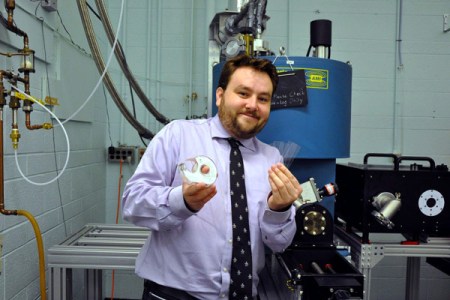A team of international researchers headed by physicists from the University of Toronto has devised a simple method that utilizes Scotch poster tape to induce high-temperature superconductivity for the first time in a semiconductor.
 University of Toronto's Ken Burch of the Department of Physics and Institute for Optical Sciences (photo by Diana Tyszko)
University of Toronto's Ken Burch of the Department of Physics and Institute for Optical Sciences (photo by Diana Tyszko)
This technique opens up the door for the development of innovative devices to optimize energy efficiency and for use in quantum computing. High-temperature superconducting materials conduct electricity without losing energy and heating up at liquid nitrogen temperatures. At present, they are used to transmit electricity with minimum loss and as the building blocks for the development of future devices such as quantum computers.
Cuprates are the materials demonstrating high-temperature superconducting properties. However, it was believed that it is not possible to integrate these cuprates with semiconductors. This significantly limits the practical applications of the cuprates as well as the observation of new effects they may produce. For instance, it is difficult to explore the proximity effect phenomenon whereby one material’s superconductivity induces superconductivity in a semiconductor, which is otherwise normal since fundamental quantum mechanics demands materials to be in near-perfect contact.
Team Leader, Ken Burch, a University of Toronto physicist, stated that junctions between superconductors and semiconductors were normally made using complicated material growth procedures and by fabricating devices with nano-scale features. On the other hand, the cuprates possess an exclusive structure and complicated chemical composition that make their integration process with a typical semiconductor impossible.
For this purpose, the team utilized glass slides and the Scotch poster tape to position high-temperature superconductors close to a topological insulator, a special kind of semiconductor. Topological insulators act like conductors at the surface but are like semiconductors in the bulk. Using this combination, the team demonstrated induced superconductivity for the first time in these innovative semiconductors.